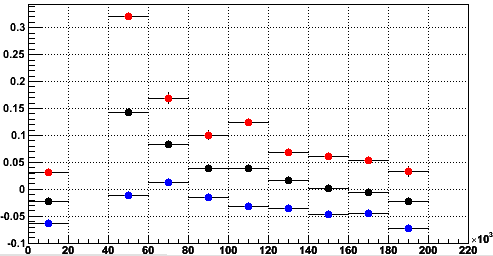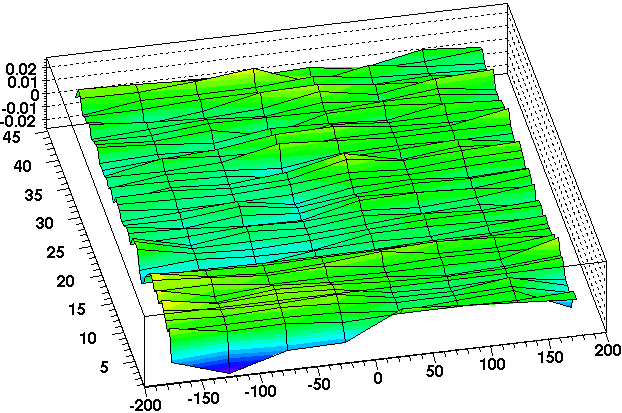pp62 (2006)
I decided not to correct for SpaceCharge and GridLeak in the 62GeV p+p dataset from 2006. This decision was based on the following points. Note that the plots are from some of the early production of P06ie (the conclusions were made from a smaller pre-production sample, but I could make the plots with better statistics from the production).
Signed DCA
Signed DCA profile versus BBC sum (east+west), where the red markers are from using east-TPC-only tracks, blue is west-TPC-only, and black is all tracks combined:Some observations:
- The lowest luminosity bin does not fit the pattern of the higher luminosity data (it seems to have only small distortions, which is what we would like to see!).
- For the rest, there appears to be some luminosity dependence, and it goes it the correct direction for this field (negative slope for positive field).
- The east and west TPC are offset from each other. My first guess on this was that the Field Cage Shorts wasn't doing it's job so well on the east, and this was causing a shifted sDCA. But other east-west differences show up (see the next section) which hint that the shorted ring may not be the problem.
- The overall effects are small, with sDCA values generally of a few hundred microns. A plot of the track-by-track sDCA can be found here, and I estimate that overall the sDCA is offset from zero by about 300-400 microns, with an RMS of about 500 microns (due to the luminosity range).
Residuals
Global track residuals at low (left, BBC sum < 1e5) and high (right, BBC sum > 1.5e5) luminosities versus Z and padrow:Key points:
- These distortions are quite small, producing residuals in the range of 100-200 microns.
- There is a notable east-west difference, and the distortions appear to be almost non-existent in the west. Some east-west differences have been observed in the past, but were atop a much larger distortion, and were considered not worth worrying about.
- Almost no z-dependence is at odds with our correction model.
- The high luminosity data appears less distorted than the low luminosity (which agrees with the sDCA plots above). Could it really be that what I am labeling as low luminosity (low BBC sum rate) is actually more distorted? Perhaps some backgrounds existed during the periods of low luminosity data, which went away during the periods of higher luminosity (which tended to be earlier during the 62 GeV running).
Summary
First, it is worthwhile to note that our ionization distortion correction machinery is not set up for east/west differences. Using a sagitta error of 400+/-500 microns, here is the estimated error in transverse momentum reconstruction of primary tracks, in delta Pt / Pt^2 (fractional momentum error per GeV/c of momentum):We can see that we expect something like an error pf 0.33% per GeV/c of Pt. This corresponds to an average error of 3 MeV/c on a Pt = 1 GeV/c track, and about 85 MeV/c on a 5 GeV/c track (with fluctuations of about +/-100 MeV/c from the mean). There are less than 20 million events with TPC information in this pp62 dataset (mostly the "mb" trigger). This will statistically limit any analyis from high-pt studies, precluding the need to have the data calibrated to higher precision than already exists in this uncorrected data.



